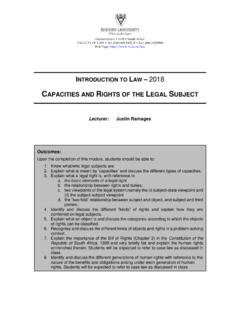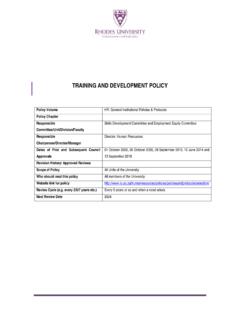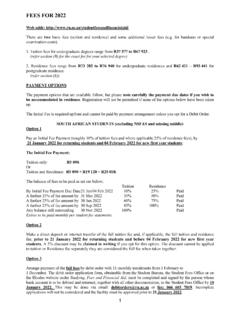Transcription of FOUNDATIONS OF LAW - Rhodes University
1 1 Grahamstown 6140 south Africa FACULTY OF LAW Tel: (046) 603 8427/8 Fax: (046) 6228960 Web Page: FOUNDATIONS OF LAW Mrs E. Davies E-mail: 2019 2 SOURCES OF LAW 1. COMMON LAW Roman Law XII Tables Praetorian Edict Aedilitian Remedies Justinian s Codification Canon Law Glossators/Commentators Reception of Roman Law in the Netherlands Roman Dutch Law English Law south african Common Law 2. CONSTITUTION D Kleyn & F Viljoen Beginner s Guide for Law Students 5ed (2018), Juta: Cape Town 156 181 (chapter 5) T Humby, (ed) et al Introduction to Law and Legal Skills in south Africa (2012), Oxford University Press: Cape Town 21 - 44 Meintjies Van der Walt et al Introduction to south african Law: Fresh Perspectives 2nd edition, (2011) Heineman: Cape Town (chapter 3) 3.
2 LEGISLATION D Kleyn & F Viljoen Beginner s Guide for Law Students 5ed (2018), Juta: Cape Town 60 - 82 T Humby, (ed) et al Introduction to Law and Legal Skills in south Africa (2012), Oxford University Press: Cape Town 169 184 4. JUDICIAL PRECEDENT D Kleyn & F Viljoen Beginner s Guide for Law Students 5ed (2018), Juta: Cape Town 82 - 121 5. CUSTOM D Kleyn & F Viljoen Beginner s Guide for Law Students 5ed (2018), Juta: Cape Town 122 124 L. Du Plessis An Introduction to Law 3rd ed (1999), Juta: Cape Town 237 - 239 WJ Hosten An Introduction to south african Law & Legal Theory 2nd ed (1995) (revised reprinted 2008), Lexis Nexis, Durban 486 - 491 3 6.
3 INDIGENOUS LAW D Kleyn & F Viljoen Beginner s Guide for Law Students 5ed (2018), Juta: Cape Town 124 - 129 L. Du Plessis An Introduction to Law 3rd ed (1999), Juta: Cape Town 67 - 74 T Humby, (ed) et al Introduction to Law and Legal Skills in south Africa (2012), Oxford University Press: Cape Town 110 - 114 SOURCES OF LAW As south african Law has many sources ie. Common law, legislation or statutes, judicial precedent (court decisions), indigenous law, custom and legal academic writings, it is of practical importance for lawyers to be aware of these different sources which provide the key to the content of the law.
4 For it is in these sources that one finds the law and gets to know it. Furthermore, it provides lawyers with authority for their arguments as they must be able to justify their assertions of a particular viewpoint. To do this, lawyers may rely on the provisions of a statute, a court decision, and opinion of one of the old authorities etc. Not all sources of law, however, have the same authority. Some have binding authority (eg Constitutional Court decisions) while others have merely persuasive authority (eg writings of modern authors or the decisions of foreign courts).
5 We will be commencing this course with Common Law as a source of our law and we will look at Roman Law, Roman Dutch Law, the influence of English Law and finally south african Common Law. In the second term we will look at the other sources legislation, the constitution, judicial precedent, custom and indigenous law. TWELVE TABLES I Of summoning before the magistrate II Of judicial proceedings III Of execution IV Of paternal power V Of inheritance and tutelage VI Of ownership and possession VII Of the law concerning land VIII Of wrongs IX Of public law X Of sacred law XI Supplementary laws XII Supplementary laws 4 TABLE I: Of summoning before the magistrate If a person be summoned to appear before the magistrate, he must go: if he does not go the plaintiff may call witnesses and take him by force.
6 If the defendant evades the notice to appear, or takes to his heels, the plaintiff may detain him by force. If the defendant is prevented from attending by reason of illness or old age, the plaintiff must find him a conveyance, although he is not obliged to provide a covered carriage. The surety for a landowner (or taxpayer) must also be a landowner (or taxpayer): for anyone other than a landowner (or taxpayer) anyone who is willing may be his surety. Where the parties come to terms, the judge shall announce the settlement.
7 Where the parties do not come to terms, the plaintiff must state his case before noon in the Comitium, or in the forum, in the presence of the defendant. After midday, if one of the parties has not appeared, judgment shall be given by default in favour of the party present. If both parties are present, the proceedings terminate at sunset. Both parties must enter into recognisances for reappearance. TABLE II: Of judicial proceedings In the sacramental action five hundred (or fifty, where the amount involved in the dispute is less than 1000) pound pieces of copper (asses) must be deposited in court as security for costs.
8 The case may be adjourned on account of the serious illness of the judge or arbitrator or one of the parties, or if one of the parties is an alien. He who wants a person as a witness must go to his house and summon him in a loud voice to attend on the third market day following. If a theft has been compromised the action is extinguished. TABLE III: Of execution Thirty days are allowed for the payment of debts admitted or adjudged due by pronouncement in court. After this period has elapsed, the defaulter may be seized by the creditor and brought before the magistrate.
9 If the judgment is not satisfied, and no one offers as surety on the debtor s behalf, the creditor may take this debtor and bind his hands or feet with fetters not exceeding fifteen pounds in weight, or less if the creditor so desires. If he wishes the debtor may find his own sustenance; otherwise the creditor must give him one pound of bread a day, or more if he (the creditor) so desires. 5 In default of payment or satisfactory security, the debtor may be kept in bonds for sixty days, and during this time the debtor shall, on three successive market days, be brought before the praetor in the Comitium and the amount of the debt shall there be publicly declared.
10 After the third market day the debtor may be punished with death, or sold beyond the Tiber. If there is more than one creditor the debtor s body may be divided between them, and if the parts be greater or less than they should be, no liability is entailed. TABLE IV: Of paternal power Monstrous or deformed offspring may be immediately destroyed by the father. A father has absolute power over his legitimate children throughout their life: he may imprison, flog, chain or sell them, or even take their life, however exalted their position and however meritorious their public service.










